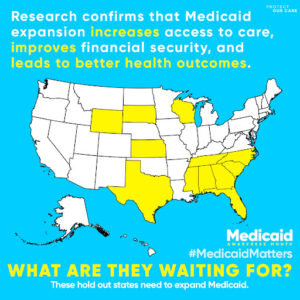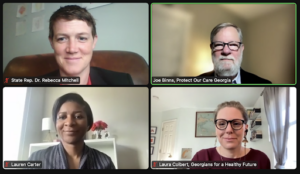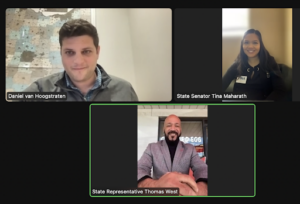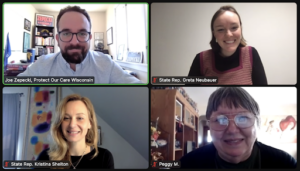MEMORANDUM
TO: Interested Parties
FR: Leslie Dach and Brad Woodhouse, Protect Our Care
DT: May 2, 2022
MEMO: Congress Must Act Quickly to Stop Health Insurance Premium Increases
If Congress fails to act, millions of families will pay thousands more for health insurance in 2023. The American Rescue Plan saved families thousands on their premiums, but the expanded tax credits that powered those savings will expire at the end of 2022 and, without Congressional action, premiums for next year’s plans will rise dramatically for those who buy insurance on their own.
In a number of states, 2023 premiums will be public starting in July, with official notices in all states sent to enrollees starting in the early fall. Open enrollment for 2023 plans begins on November 1st 2022, a week before Election Day. As people go to the polls, these premium increases will be front and center.
Background
Rising prices are keeping Americans up at night and they are depending on Congress to do something about it. Addressing health care costs is one of the most effective ways to lower the cost of living and put more money in working families’ pockets. Americans continue to pay more for their health care than anyone in the world, with the average family spending thousands of dollars per year in premiums, deductibles, and prescription drug costs.
Last year, Democrats passed the American Rescue Plan, increasing federal assistance and lowering health insurance costs for millions of Americans who buy insurance on their own. The American Rescue Plan guaranteed coverage that costs less than 8.5 percent of income, eliminated premiums for those making less than 150 percent of the federal poverty level, and expanded eligibility for premium tax credits for those making over 400 percent of the federal poverty line. Overall, 9 million Americans benefited from these lower costs.
Because of the American Rescue Plan, millions were able to enroll in a quality plan for $10 or less per month, and families saved an average of $2,400 a year on their insurance premiums. As a result a record number of Americans —14.5 million — are now covered by an ACA Marketplace plan. For so many, this access to care means the peace of mind knowing that a medical emergency will not result in bankruptcy.
Polling Shows Americans Strongly Support Premium Savings
Poll after poll shows that voters overwhelmingly support making the American Rescue Plan’s premiums permanent. Democrats ran and won on health care in 2018 and 2020, and voters are depending on them to deliver. A closer look at recent polling:
- KFF Poll Finds Americans Overwhelmingly Support Biden’s Plan To Lower Health Care Costs. [KFF, 3/31/22]
- ACA Premium Savings. 63 percent prioritize making permanent the financial help for people buying marketplace health coverage that was included in COVID-19 relief law. [KFF, 3/31/22]
- Pew Survey Finds Health Care Ranked Third Most Important Issue For Americans. [Pew Research, 3/24/22]
- Health Care Remains Top Issue. 60 percent of voters ranked health care as a top issue for the fall election, with 74 percent of Democrats saying it is very important to their vote and 44 percent of Republicans voters saying the same. [Pew Research, 3/24/22]
- Navigator Finds Lowering Health Care Premiums For People Purchasing Coverage Remains Priority. Four out of the five top priorities are health provisions included in President Biden’s agenda. [Navigator, 1/28/22]
- Lowering Premiums. Overall, 78 percent believed lowering premiums for people purchasing health coverage on their own was a good reason to pass Biden’s agenda, including 91 percent of Democrats, 77 percent of independents, and 64 percent of Republicans. [Navigator, 1/28/22]
Timeline
Here is the timeline for the public release of 2023 health insurance premiums:
- Currently Underway: Insurance providers are currently negotiating premium rates for 2023. If Congress does not act to extend the ARP’s premiums savings, insurers will be forced to assume the tax credits will expire at the end of the year, which will result in sizable premium price increases.
- July: Most premium rate changes will be finalized and public beginning at the start of July.
- September & October: Insurers planning to offer health plans on the ACA marketplaces are required to submit their premiums for 2023 to state or federal regulators. Enrollees will be notified of plan price changes officially in September and October, with rates required to be finalized by October 15.
- November 1: The annual open enrollment period for ACA marketplaces begins November 1.
- November 8: Election Day is November 8, one week after open enrollment for 2023 is set to begin.
Bottom line
While President Biden and Democrats are working tirelessly to make health care more affordable, Republican lawmakers oppose lowering premium costs for families. Every Republican in Congress voted against the American Rescue Plan, and the GOP has offered zero solutions to lower the price of health care.
If Congress fails to extend the American Rescue Plan’s tax credits, news of premiums skyrocketing will be front and center just as Americans begin signing up for coverage in November. Only Congress can prevent widespread premium hikes. Every member must get on board to ensure hardworking families can continue to access the health care they need.
Additional Resources
Fact Sheet: At Risk: Health Care Savings Millions Depend On
The American Rescue Plan boldly built on the strong foundation of the ACA by lowering premiums and expanding access to coverage. In 2021, 14.5 million people signed up for health coverage through the ACA Marketplace. This is the highest number of Americans to ever enroll on the Marketplaces and it is thanks to President Biden’s American Rescue Plan. The ARP made health insurance more affordable and accessible than ever, helping families, reducing racial disparities, and giving Americans a little breathing room.
A recent report from the Robert Wood Johnson Foundation and Urban Institute found more than three million people would lose their coverage if Congress fails to make the American Rescue Plan’s enhanced premium tax credits permanent. The study also shows that millions of people currently eligible for the enhanced premium tax credits could pay thousands of dollars more a year for their health insurance without action. Congress must act to make the savings provided in the American Rescue Plan permanent and protect the progress Americans have gained in the fight for affordable health care.
Read the entire fact sheet here.






